Patrick Smith’s Billion Person Theater
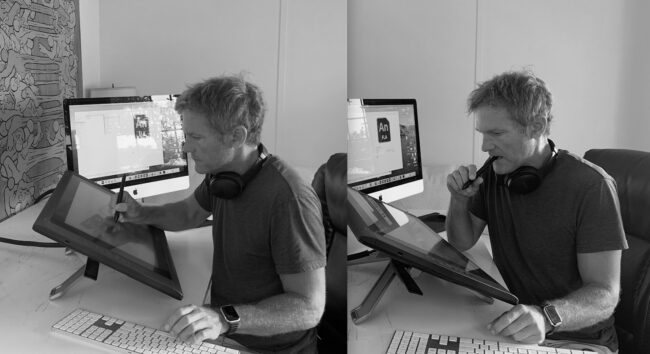
By Robby Gilbert
Patrick Smith began his animation career in 1994, honing his talents in the studios of New York. This was an interesting time for animation; a point of inflection whereby the last vestiges of the traditional studio systems were drying up like cel vinyl, and the digital juggernaut sparked a race to determine who could stake the broadest claim in the wild west of new technologies and platforms. New York’s media behemoths poured millions into digital distribution—and for animators it became quite literally an ‘arms’ race. Those who could quickly adapt to this new paradigm of bits and bytes would have a shot at success in the looming uncertainty of the new century, while those who remained resistant to these changes, with a few exceptions, packed up their animation disks and grumbled goodbye to any recognizable aspects of an industry that had remained largely the same since 1912. A new generation of artists began to flourish during this era—artists who had witnessed the days of ‘illustrated radio,’ the first Macintosh and Amiga computers, and the explosion of animation production during a period that would become known as the second golden age.
Pat Smith is one of these artists, arriving in New York on the strength of his abilities and ideas finding early success animating a spot for MTV. He learned on the job, working at MTV Studios, Jumbo Pictures, and just about every remaining studio in New York at the time.

“I was learning on the job,” remembers Pat “I think that’s kind of the New York way. I never wanted to work for Pixar. I never wanted to work for Disney. My goal was to make my own films. From the beginning, that was my primary goal—to just create my own art and my own stories and then it metastasized into making a living as a short filmmaker. And that has been my life for the last 25 years.”
Pat Smith now works from the home he shares with his wife and daughter in Montauk, Long Island. He has managed to find success as a YouTuber, one of the first —and one of the few— animators to figure out how to monetize the platform and carry forward the independent festival animation tradition into the age of the hand-held screen. His work has reached an audience numbering in the hundreds of millions, which he has been able to translate into a six-figure income stream. But more than just financial success, Smith has figured out how to harness this platform to fine-tune his practice and create work that resonates with audiences in places such as India, Vietnam, and Malaysia. He is a wizard of the web, animating a rich universe of pantomimic splendor and tapping into a global audience —much like Chaplin and the great film stars of the silent era— by mastering the language of movement and story to communicate ideas to millions around the world.
During a recent interview with Pat Smith, I realized that I was speaking to one of the foremost thinkers and pioneers of 21st century independent animation and distribution. He generously shares his knowledge with anyone interested in listening. Tapping into the algorithmic power of Google analytics, his methods and proven success challenge the historical notions of animation production, distribution and audience. He is not only a master animator, but one of the very few to embrace the algorithm itself as a contemporary form of pencil test and exposure sheet, providing an exemplary model for a new generation of independent animators.
(this interview has been edited for length and clarity)
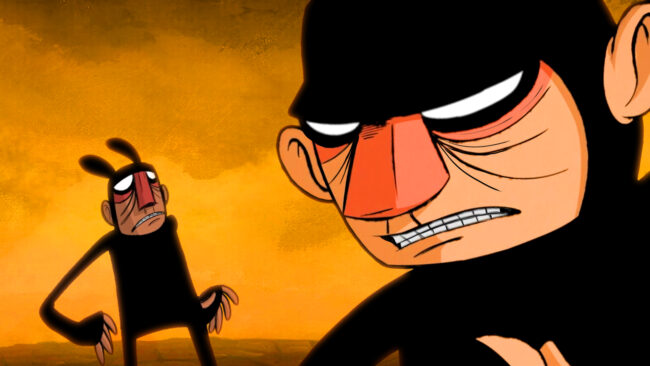
Talk to me a little bit about monetizing YouTube and your experiences with that.
YouTube is now really getting into gear. This is potentially a home for short filmmakers— particularly for animation— because animation has found a nice little place on YouTube. Very little competition. The people that could compete don’t take it seriously, and the old guard totally don’t know how to do it and have refused to go there. Matter of fact, I think a lot of filmmakers I respect have this odd [aversion to] YouTube.
A resistance?
Yes. This talk I did in Singapore last year went over 3 hours and it was just, it’s too big of a talk,
So, I was thinking, maybe I should start breaking it apart. It’s called The Billion Person Theater.”
I just love the title.
And it’s my thoughts on new media and how it’s oddly getting ignored, unless it’s Netflix or stuff like that, which is not a home for independents. I’m talking about making your independent artistic vision in the format of a short film. On your own channel. Truly independent.
So, the billion-person theater, in my view, is a Gutenberg printing press revolution for animation. You’re talking about the accessibility to hundreds of millions of people. And I’m not exaggerating. I have a film that has close to two hundred and fifty million views.
Now, it’s difficult to get your head around that as an animator, because I’m used to celebrating over a film festival with maybe a thousand people, or maybe a decade ago, a Vimeo “staff pick” video going viral and getting a hundred thousand views.
The idea of breaking the threshold of 100-200 million is mind blowing.
Yes, and then there’s a whole other element to that. Myself (and many others) initially got into animation because of those early VHS compilations of animation. The International Tournee, Animation Celebration… you know, a lot of those collections Ron Diamond put together in the 90’s. They exposed thousands of people to independent animation. Now, let’s take a YouTube channel serving a similar role. But now, the exposure is in the millions so it could be a great vehicle for inspiration and getting others into animation, people that would otherwise not even know it exists.
I did notice your view count was way up there. You spoke earlier about confusion of the term, ‘independent.’ Do you want to elaborate on that a little bit?
Younger people, particularly in Hollywood, are making great stuff. But it’s all pilot and development based, it has a sheen of commercialism to it, it lacks the spirit of an independent production. It doesn’t seem to me to be an acute artistic vision. And they’ve kind of taken over the word ‘independent.’ And maybe they’re right in one sense, that it’s independently produced. There was a fantastic back and forth about this on Elliot Cowan’s X feed.
An independent short, to me, is always first a spirit and culture, you know? It’s a certain type of soul injected into the piece and the way it’s crafted. Historically, these types of films have been distributed through film festivals and alternative venues more than mainstream channels. You know, it’s making something where there’s no conditions, no gatekeeper telling you what to make. It’s unconditional artistic vision. You’re making it to communicate your ideas directly to your audience, not a producer, development exec or a client.
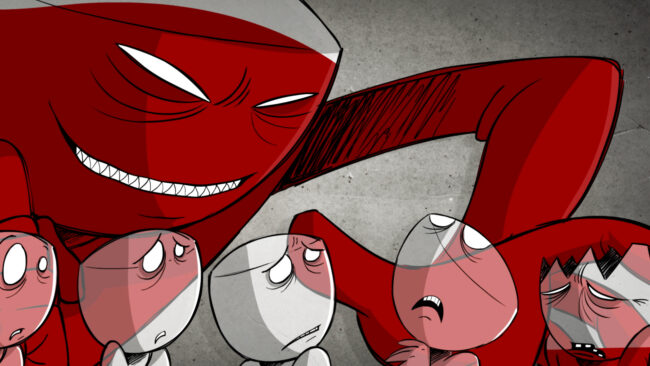
I’m just really intrigued by this idea of the billion-person theater. That’s a fantastic idea for a book.
It’s a big subject. On the most simplistic level it covers how to make a living on YouTube. You know, perhaps maybe that’s overly practical, but I’m trying to think of who would read it—the impact of the change of the distribution dynamic. Making a living creating personal short films has rarely been a reality for animators.
And there’s a lot of animators that had one viral YouTube hit, but they never really ran with it, never grew into this new system of distribution. The very first thing any Youtuber must achieve is that first viral hit, and then you gotta build on that. It’s a missed opportunity if you just sit on a viral laurel.
Animation is sometimes looking backwards in a way, or looking at the already existing markets and that kind of thing. I was speaking with Dan Haskett recently and he was talking about how the industry often just wants to replicate what’s already been done, and how in many ways that’s backwards. But you’re very much looking forward. And the second thing that comes to mind is that a lot of the older generation really held closely those ideas about animation and making a living at it for the most part. You seem to be advocating sharing your secrets, down to how to monetize the stuff.
When you’re dealing with hundreds of millions of people, there’s no reason not to share what you have learned. The audience is just that large. Matter of fact, I think there needs to be more sharing, particularly within independents, because there’s many ways to do this. It reminds me, it is one of the things that Spike from Spike and Mike taught me right in the beginning of my career. He was a big advocate of non-exclusive content.
I asked, ‘Why don’t you want this all to yourself?’
He goes, ‘No, that’s the wrong way to look at it.’
He said, ‘Your film succeeding outside of Spike and Mike helps Spike and Mike, because we have it also, and will be known for having it in our collection.’
So that’s the way he looked at it. And that always influenced me. And I thought that was a brilliant approach to animation. The more popular, the better. The more people see it, the better. Sometimes it’s tempting to think the audience is small just because we’ve been conditioned to think it’s small.
There’s a lot of conditioning in the expectation of the animation marketplace, the viewership, that kind of thing.
During my lecture I went on and on about this. I had to cut it short and honestly, it was funny because a segment of the audience didn’t seem to appreciate the lecture. They sat there. They were very closed off to it, because the thing is, YouTube is a little bit of a populist platform, you know? It’s not a home for high art. Or maybe it is.
Well, you know what? Who’s to say? I always say that YouTube is an open architecture platform. You gotta find your audience, right? And YouTube will help you find your audience. They are very good at that. It is in their direct interest for you to find your audience. So maybe there is an audience for Avant Garde film. Who knows?
In my experience, the most successful films on YouTube are story oriented. Films that hold your attention. Sometimes they’re not the most professionally produced, but they hold the audience. And then you realize, the majority of the audience for animation on YouTube is not animators. So they’re not looking at it in the same way as animators are.
The type of films that YouTube likes to promote —you go on the analytics and it shows you exactly how your film performs and, and these analytics are truth, because they are statistics taken from millions of people. And, there’s very little error in that. You’re talking about millions. You get into this idea of—your audience is truly the entity you are answering to, if they don’t watch it, YouTube doesn’t promote it to them, and then searches for a new audience. It’s that simple.
In your films, there’s often a sort of a populist message in terms of an individual’s resistance to a greater cultural manipulator. Do you want to elaborate on that?
Well, films are a communication tool, and if you’re not communicating with anyone, why bother? You’re just putting out films about yourself, or to your colleagues, or perhaps, you know, cadres of experts you want to impress. I would rather make a film for the ‘average’ person. Perhaps this kid who’s interested in animation, but has never really been exposed to it outside of a Pixar film, or, at best, anime. They’ve never been to a film festival (similar to the majority of the planet). Their idea of animation is limited. In this regard, an indie animated short fills a void. This is world-wide. A large portion of my audience is in India, Vietnam, Indonesia, Brazil. YouTube, of course, provides you with every analytic possible, including the specific location of all your subs and where they are the most active.
As for the stories I choose to tell, I stick with basic stuff… power dynamics expressed with scale, the individual vs. the group, passing along knowledge vs. indoctrination… all this stuff is ripe for clever metaphors and interesting visual interpretations and contrasts. And they’re all stories that people can project their own experiences into. That’s the best part, I love that.
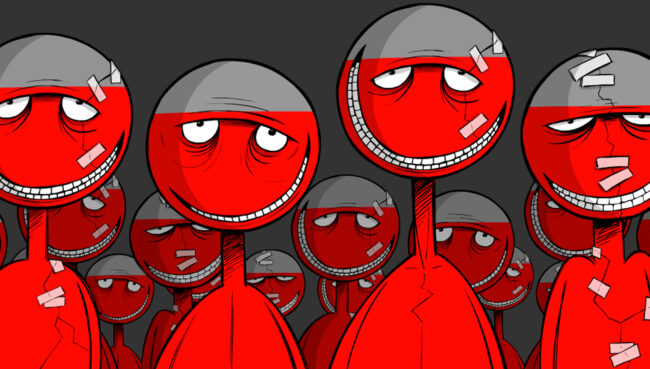
And your work speaks beyond a particular language, which is also quite wonderful.
This is maybe why YouTube was a perfect storm for me: I had a library of shorts and they were all pantomime and story oriented. You know, this is a pretty unique situation and I think it was the main contributor to my channel’s success.
And it happens to have fit what YouTube people wanted perfectly, because the worldwide audience loves pantomime.
When you make a film in English, you’re pretty much limiting yourself to English speaking countries. I mean, English-speaking countries are good, they have the highest advertising rates, RPM…. which is a Rate Per Mile, which is a way to judge how much revenue your vid brings in. But English-speaking countries just don’t provide the views like Brazil, Indonesia, Vietnam, Malaysia, and Russia— these countries have lower RPM but high numbers. So, in my experience, it’s better to hit high numbers. Also, the view count is truly the most important analytic to me, going back to the distinct belief that this is communication, and my artistic goal will always be to communicate with the most people possible.
I was at ANNECY recently. I was walking with my colleague Lynn Tomlinson, a wonderful mixed-media animator.
Lynn is amazing.
Anyway, it was a time when we both knew people that had films on Youtube that were gaining traction with millions of views (Animators like PES and Felix Colgrave as well as Studio Filmbilder). This is right when one of my films was first kind of starting to blow up. We concluded our conversation saying that exposure to millions of people could change the face of the animated short, and we also noted how little anyone was talking about it, even at such an animation focused event like Annecy.
I brought it up again with my buddy who was having a party that evening and he didn’t seem to think much of it other than the fact that his spouse had also had a viral personal film, 50 million views. I mean, these are not normal numbers for independent shorts. And definitely not something to shrug your shoulders about.
It could be a revolutionary moment where great works of art break down this barrier and actually flood out into the plains of all these areas of the world that have not been exposed to independent animation. Based on the numbers you can’t just ignore that.
Why do you think animators ignore this Billion Person Theater?
I think a reason why it’s ignored is just because the genome is so massive. YouTube has some of the most interesting things on it, and it also has the most un-interesting things on it. It’s very easy to just see this massive glut of cat videos and podcasts and just write off the whole thing.
Also, it’s difficult for a lot of animators to think that YouTube is much more than a place to post your demo-reel. Most animators don’t believe anyone can make a living on shorts. In reality, YouTube has the potential of creating a steady revenue stream for animators, oftentimes a passive stream. YouTube is the client and the client is the billions of people on the planet.
Now, you can criticize that all you want. But remember, the big difference between the classic audience in the theater and the billion-person theater is that the billion person theater is not captive, so it puts a larger burden on the filmmaker, especially early on. You gotta grab them. You gotta grab them because there are a multitude of distractions when you’re watching on a cell phone, and the vast majority of these people are watching on a cell phone.
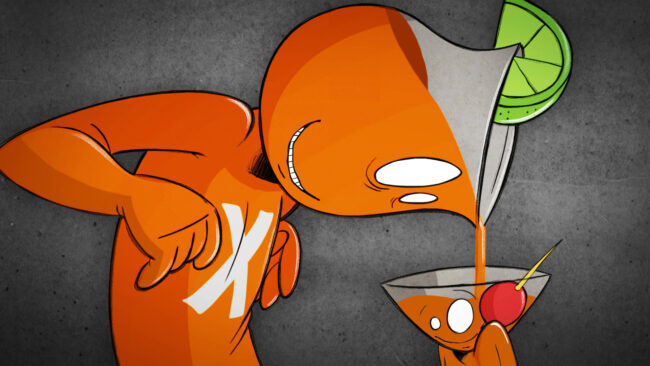
What do you anticipate comes down the road from this billion-person theater? I mean, are you actively preparing for that?
I can’t say I’m prepared for anything. Other than creating the best films I can. And I use the features Youtube offers to do just that. For example, you’ve probably seen “end screen” links that are offered after watching a YouTube video. The content creator controls that. So that’s off-algorithm. I use that in many ways to test the effectiveness of my film.
What I do is I’ll put an “unlisted” link of a rough cut of a new film at the end of an already successful film, a film that consistently gets fifty thousand to a hundred thousand views a day.
Now when people watch the rough cut, I collect all the analytics, this is raw data from people who decided to click on it. This is off-algorithm, so it’s not gonna hurt me if they click off, or lose interest. I read all the comments and glean all I can from the analytics. I’ll run it for a week, and I’ll probably get 10-30 thousand views. Then I pull it off of YouTube, and I have all of the analytics from twenty thousand people that watch the film, and I can see exactly where they lost interest. I can see exactly where they maybe rewatch something.
This is Google. Google is filled with brilliant geek programmers. They give you every single element. They give you more info than you need. And then I can see the type of questions they ask, the questions like, oh, ‘I didn’t get this.’ Like even goofy ones, you know, ‘this is great,’ ‘this didn’t work,’ whatever. And I’m sitting there, and it’s like I’m back in a film festival Q & A. Except the theater is filled with 30,000 people, and I have intimate knowledge of what worked and didn’t work in the film they just watched. It’s the ultimate Q & A. I call this “Pre-screening” a film, and I repeat it as often as I can until I get the best results I think the film can get prior to the final public posting.
The changes I make really make a difference to the performance of the film. For example, typically you will lose 25 % of people on the title. That’s natural. If it goes below 25 %, I know that the title might be a little long, or, hey, maybe I should animate the title instead of it just being up there static. So, I go back, animate the title, then post another “pre-screen” and see how it affected the analytics… and hey, the average view duration just increased 12%!!
I take these studies very seriously, and they really help me to edit and sharpen my films. And I can tell you right now, the films that I have done where I didn’t do this study, perform measurably worse than the ones I did do the study.
That’s fascinating. Prescreen is what you call it?
I’ve done up to six prescreens on a single film. So, I sharpen the editing to the point where I can’t improve. And then I realize it’s time. It’s time to post it. This editing and timing has reached maximum potential. What you’re looking for in the analytics is a level graph. Vertical axis is the percentage viewed; horizontal axis is time. So, if the graph is going down that means people are losing interest over time.
It always goes down at the beginning. But if it goes down and then stays even, that is gold. Matter of fact, if it goes down a little bit incrementally, that’s okay too. But what you want is an even line. Youtube calls this line a “top moment.” If you get an even line at 75 %, you’re sitting on a viral video. I can almost predict it.
Inevitably, when you start explaining this stuff, I imagine you’re going to get somebody who’s going to ask you about AI—basically AI generation of animation. And if you’re dealing with algorithms, potentially you’ve got a replicable formula that just works. Is that something you think about? If the data can determine the power of the storytelling or the interest level, then could you harness that data in order to generate the optimal framework for a film?
I don’t know. The answer is, I don’t think that my film is being crafted in this way. I think it’s being sharpened. Okay? The film itself is made with my own personal vision. I have no idea if people wanna watch what I’m making. Right now, I’m making a borderline horror genre film. It’s just in me, it’s a story I need to tell. All right, that said, I’m going to sharpen this film. Sharpen the editing so the story is told in the best, most efficient and effective way possible. In that way, it’s far from a focus group. So that’s the way I see it. Matter of fact, I had this back and forth during my talk in Singapore. Some people in the group suggested this as an un-artistic way of making a film, and it interrupted the artist’s vision, compromising the vision of the art, the making of the film.
And I disagree. The film is created in my vision. It’s simply being optimized. As a filmmaker, we need input, especially at the end, because we are just so close to the piece, we lose objectivity. Prescreening roughs can really help that. Furthermore, I create festival cuts for many of my films. This is where I make a special edit of a film that is more fitting for a theatrical venue.
Because when you’re dealing with a theater as opposed to a hand-held phone, you are dealing with a captive audience. You would be foolish to think the same film edit could perform equally well on both of those. So what I do for festival cuts, I often slow things down. I put full credits on the back end. Whereas online, I kind of zing through the credits, this is because, let’s say, if you have 20 seconds of credits, that 20 seconds in a three-minute film will really hurt average view duration. And the algorithm will treat that as a drop off of interest.
That’s really interesting because now suddenly as an animator you’re not just managing a frame rate and timing of sound and synchronization and drawing and anticipation…all that good stuff. You’re also managing attention span…that’s another level of timing. It’s another way of thinking about timing.
I mean, we gotta use wherever we got, right? As a filmmaker, when you’re making a short, you’re a lot more than an animator. You’re a producer, an editor, you’re wearing a lot of hats. And you have to be sensitive to all this type of stuff. You don’t want to ignore something that is available in your toolbox
The way you’re thinking about it is really inspiring. This is pioneering stuff in our industry. You seem to have figured out, maybe not completely, but at least more than anyone, the formula.
I do think my angle might be unique, because I’m coming at it as a filmmaker whose first goal is to make an aesthetically true vision of what I want to communicate. So, I’m trying to get views, yes, but more than that I’m trying to communicate my ideas and my stories. Also, of course, I’m trying to make a living. But these are highly crafted individual works of art.

And the algorithms are part of the craft.
This interview went into far greater detail about Pat’s process than space allows for here. He is still experimenting with the specifics of explaining his unique approach, but certainly the proof is in the pudding. You can enjoy Patrick Smith’s films in a festival near you or, perhaps better yet, in the Billion Person Theater.
—Robby Gilbert is an animator, artist, and a professor of animation and the moving image at Rowan University. He is currently working on a book about New York’s animation culture for Palgrave Animation, due out in December, 2024.





